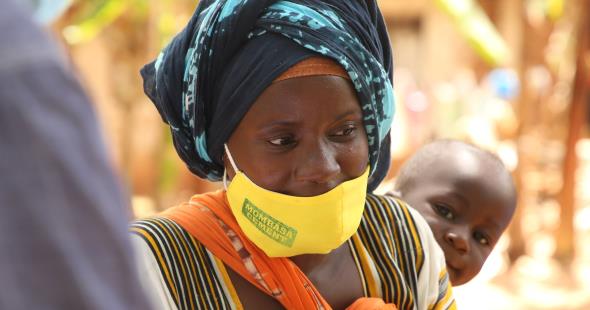Women & children

GOAL: Strengthen antenatal screening for communicable and non-communicable diseases (NCDs), and reduce deaths from undiagnosed fever and pneumonia
Primary healthcare facilities play a critical role in supporting a healthy pregnancy and childhood, as they are the first port of call for antenatal screening and care for childhood illnesses. Accurate diagnosis at a primary care facility determines whether a patient can be treated then and there, or if they need to be referred to higher levels of care – yet only 1% of primary care facilities in low- and middle-income countries (LMICs) have the basic diagnostic capacity to do this. Access to essential diagnostic tests in primary care settings must be improved, to strengthen antenatal screening for communicable diseases and NCDs, and support differential diagnosis of patients presenting with fever and pneumonia.
Improve antenatal care screening for non-communicable and infectious diseases
Hypertensive disorders of pregnancy and gestational diabetes contribute extensively to over 2.7 million infant deaths, 2.6 million stillbirths, 303,000 maternal deaths, and preventable maternal and infant morbidity annually. Globally, cardiovascular diseases and diabetes are responsible for almost 20 million deaths every year, occurring at a disproportional rate in LMICs (85% of all premature deaths occur in these countries). Despite evidence demonstrating the health, economic and development value of screening and detection of NCDs, particularly in women of childbearing age, many still lack access to the testing interventions necessary to achieve UHC.
Our focus is on combining our efforts in infectious disease diagnostics to screen pregnant women for HIV, syphilis, hepatitis B, and malaria, with strengthened NCD
screening globally, contributing towards the WHO target of 80% availability of affordable basic NCD technologies.
Workstreams:
- Strengthen antenatal NCD testing through better access to NCD testing overall
- Increase access to infectious disease testing for women, targeting HIV, syphilis and hepatitis B testing in antenatal care
Indicative deliverables:
- Optimized multi-parameter cardiometabolic point-of-care device
- Technology innovation for self-monitoring of blood glucose for diabetes
- Up to 5 affordable existing NCD tools available to countries (including blood glucose test strips and HbA1c tests)
- Community and patient engagement models developed for holistic, integrated chronic disease management
- HIV/syphilis/hepatitis B combination RDT with digital decision tool and impact use cases
Improve the survival and well-being of children affected by fever and pneumonia
In 2019, 5.2 million children died before they reached 5 years of age.31 Nearly half (45%) of early childhood deaths were due to infectious diseases that present with fever and other symptoms, for example a cough in the case of bacterial or viral pneumonia.32 Malaria and pneumonia are among the main contributors to those deaths resulting from inappropriate care or triage at the first point of contact with health providers. A lack of tools to support referral and treatment decisions contributes to the high mortality of children even when they reach the health system. Alongside this first triage decision, healthcare teams also need to assess the appropriate course of treatment for malaria and other illnesses. The already challenging work of frontline healthcare workers has further been exacerbated by COVID-19. It was estimated at the beginning of the pandemic that an additional 1 million children will die due to health system disruptions,33 including a lack of appropriate triage tools. Additional innovations at point-of-care and community levels are needed to tackle child mortality and morbidity by ensuring every child who needs medical attention is triaged, and patients with febrile illnesses and pneumonia are identified, monitored, and cared for at the appropriate health system level. These innovations will be key to supporting syndromic surveillance activities, and to helping countries stay on track to achieve the SDG targets of reducing under-5 mortality to at least as low as 25 deaths per 1,000 live births, and ending the malaria epidemic, by 2030.
Our focus is on on improving triage and differential diagnosis at the lowest levels of the health system.
Workstreams:
- Improve triage of children at the point of care for timely referral of severe infections and differential diagnosis between typhoid, dengue, malaria and COVID-19, to inform appropriate treatment
- Support global malaria elimination with improved tools for Plasmodium vivax and other threats to effective diagnosis
- Support the uptake of integrated fever management approaches
Indicative deliverables:
- Expanded use of at least 2 next generation electronic clinical decision aid tools
- At least 2 next-generation triage tools to support the assessment and monitoring of patients
- Bundle of point-of-care tests for fever / pneumonia management (including typhoid, dengue, malaria and COVID-19)
- At least 2 next-generation malaria tests to improve P. falciparum and P. vivax management
- Targeted country roadmaps to help advance integrated diagnostic algorithms for malaria and other febrile illnesses
Quick links

